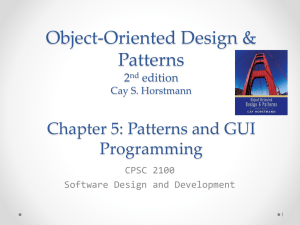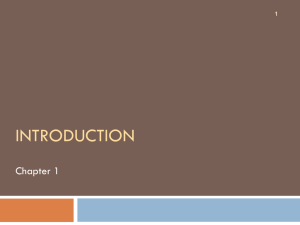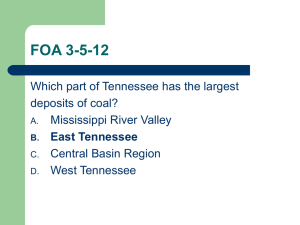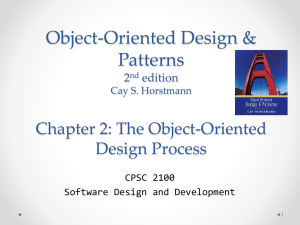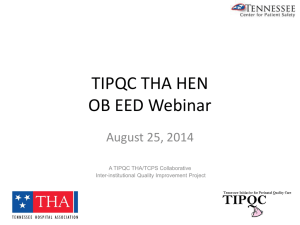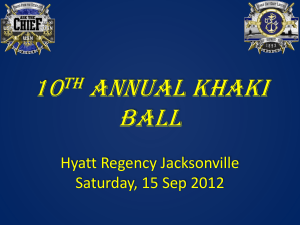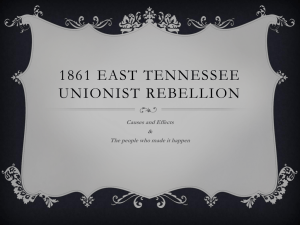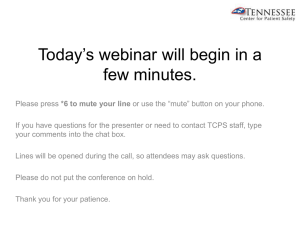Chapter 6 - The University of Tennessee at Chattanooga
advertisement
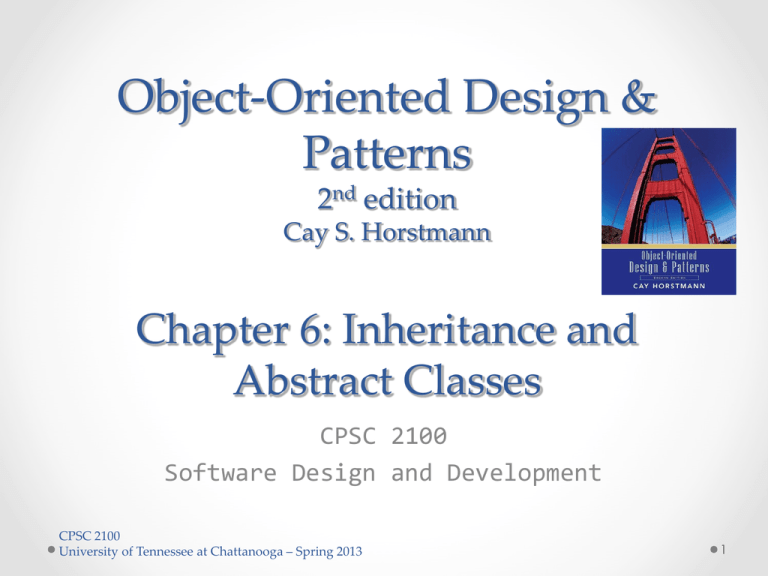
Object-Oriented Design &
Patterns
2nd edition
Cay S. Horstmann
Chapter 6: Inheritance and
Abstract Classes
CPSC 2100
Software Design and Development
CPSC 2100
University of Tennessee at Chattanooga – Spring 2013
1
Chapter Topics
•
•
•
•
•
•
•
•
•
The Concept of Inheritance.
Graphics Programming with Inheritance.
Abstract Classes.
The TEMPLATE METHOD Pattern.
Protected Interfaces.
The Hierarchy of Swing Components.
The Hierarchy of Standard Geometrical Shapes.
The Hierarchy of Exception Classes.
When Not to Use Inheritance.
CPSC 2100
University of Tennessee at Chattanooga – Spring 2013
2
Chapter Objective
• Discuss the important class relationship of inheritance.
• Examine how inheritance is used in Java class libraries.
CPSC 2100
University of Tennessee at Chattanooga – Spring 2013
3
Inheritance
• Used to model relationship between classes.
o One class represents a more general concept (Superclass)
o Another class represents a more specialized concept
(Subclass).
CPSC 2100
University of Tennessee at Chattanooga – Spring 2013
4
Modeling Specialization
• Start with simple Employee class
public class Employee
{
public Employee(String aName) { name = aName; }
public void setSalary(double aSalary) { salary =
aSalary; }
public String getName() { return name; }
public double getSalary() { return salary; }
private String name;
private double salary;
}
• Manager is a subclass
CPSC 2100
University of Tennessee at Chattanooga – Spring 2013
5
Modeling Specialization
•
•
Manager class adds new method: setBonus
Manager class overrides existing method: getSalary
o Adds salary and bonus
public class Manager extends Employee
{
public Manager(String aName) { ... }
// new method
public void setBonus(double aBonus)
{
bonus = aBonus;
}
// overrides Employee method
public double getSalary() { ... }
}
private double bonus; // new field
CPSC 2100
University of Tennessee at Chattanooga – Spring 2013
6
Modeling Specialization
Figure 1:
The Manager Class Inherits
from the Employee Class
CPSC 2100
University of Tennessee at Chattanooga – Spring 2013
7
Manager Methods and Fields
•
•
•
•
•
methods setSalary, getname (inherited from Employee).
method getSalary (overridden in Manager).
method setBonus (defined in Manager).
fields name and salary (defined in Employee).
field bonus (defined in Manager).
CPSC 2100
University of Tennessee at Chattanooga – Spring 2013
8
The Super/Sub Terminology
•
•
•
•
Why is Manager a subclass?
Isn't a Manager superior?
Doesn't a Manager object have more fields?
The set of managers is a subset of the set of employees
Figure 2:
The Set of
Managers is a
Subset of the Set
of Employee
CPSC 2100
University of Tennessee at Chattanooga – Spring 2013
9
Inheritance Hierarchies
• Real world: Hierarchies
describe general/specific
relationships:
o General concept at root of
tree.
o More specific concepts are
children.
• Programming: Inheritance
hierarchy
Figure 3:
A Hierarchy of Employee Classes
o General superclass at root
of tree.
o More specific subclasses
are children.
CPSC 2100
University of Tennessee at Chattanooga – Spring 2013
10
Liskov Substitution Principle
•
Formulated by Barbara Liskov.
o You can use a subclass object whenever a superclass object is
expected.
•
Example:
Employee e;
...
System.out.println(“name=" + e.getName());
System.out.println("salary=" + e.getSalary());
•
Can set e to Manager reference.
e = new Manager(“Barbara”);
e.getName();
e.getSalary(); // JVM Polymorphism
•
Polymorphism: Correct getSalary method is invoked.
CPSC 2100
University of Tennessee at Chattanooga – Spring 2013
11
Invoking Superclass Methods
•
Can't access private fields of superclass.
public class Manager extends Employee
{
public double getSalary()
{
return salary + bonus; // ERROR--private
field
}
...
}
•
Be careful when calling superclass method.
public double getSalary()
{
return getSalary() + bonus; //ERROR--recursive call
}
CPSC 2100
University of Tennessee at Chattanooga – Spring 2013
12
Invoking Superclass Methods
• Use super keyword
public double getSalary()
{
return super.getSalary() + bonus;
}
• super is not a reference.
• super turns off polymorphic call mechanism
enforces the superclass method to be called.
CPSC 2100
University of Tennessee at Chattanooga – Spring 2013
13
Invoking Superclass Constructors
• Use super keyword in subclass constructor:
public Manager(String aName)
{
super(aName); //calls super constructor
bonus = 0;
}
• Call to super must be first statement in subclass
constructor.
• If subclass constructor doesn't call super, superclass
must have constructor without parameters.
CPSC 2100
University of Tennessee at Chattanooga – Spring 2013
14
Preconditions
•
Precondition of redefined method at most as strong
public class Employee
{
/**
Sets the employee salary to a given value.
@param aSalary the new salary
@precondition aSalary > 0
*/
public void setSalary(double aSalary) { ... }
}
•
Can we redefine Manager.setSalary with precondition
salary > 100000?
•
No--Could be defeated:
Manager m = new Manager();
Employee e = m;
e.setSalary(50000);
CPSC 2100
University of Tennessee at Chattanooga – Spring 2013
15
Postconditions, Visibility, Exceptions
• Postcondition of redefined method at least as strong.
• Example: Employee.setSalary promises not to decrease
salary.
o Then Manager.setSalary must fulfill postcondition.
• Redefined method cannot be more private.
(Common error: omit public when redefining)
• Redefined method cannot throw more checked exceptions
than are already declared in the superclass method.
CPSC 2100
University of Tennessee at Chattanooga – Spring 2013
16
Graphic Programming with Inheritance
• Chapter 4: Create drawings by implementing Icon
interface type.
• Now: Form subclass of JComponent
public class MyComponent extends JComponent
{
public void paintComponent(Graphics g)
{
drawing instructions go here
}
...
}
• Advantage: Inherit behavior from JComponent.
• Example: Can attach mouse listener to JComponent.
CPSC 2100
University of Tennessee at Chattanooga – Spring 2013
17
Mouse Listeners
• Attach mouse listener to component.
• Can listen to mouse events (clicks) or mouse motion
events.
public interface MouseListener
{
void mouseClicked(MouseEvent event);
void mousePressed(MouseEvent event);
void mouseReleased(MouseEvent event);
void mouseEntered(MouseEvent event);
void mouseExited(MouseEvent event);
}
public interface MouseMotionListener
{
void mouseMoved(MouseEvent event);
void mouseDragged(MouseEvent event);
}
CPSC 2100
University of Tennessee at Chattanooga – Spring 2013
18
Mouse Adapters
• To simplify the implementation of listeners
MouseAdaptor.
MouseMotionAdaptor.
• What if you just want to listen to mousePressed?
public class MouseAdapter implements MouseListener
{
public void mouseClicked(MouseEvent event) {}
public void mousePressed(MouseEvent event) {}
public void mouseReleased(MouseEvent event) {}
public void mouseEntered(MouseEvent event) {}
public void mouseExited(MouseEvent event) {}
}
CPSC 2100
University of Tennessee at Chattanooga – Spring 2013
19
Mouse Adapters
• Component constructor adds listener:
addMouseListener(new MouseAdapter()
{
public void mousePressed(MouseEvent event)
{
mouse action goes here
}
});
CPSC 2100
University of Tennessee at Chattanooga – Spring 2013
20
Car Mover Program
• Use the mouse to drag a car shape.
• Car panel has mouse + mouse motion listeners.
• mousePressed remembers point of mouse press.
• mouseDragged translates car shape.
CarComponent.java
CarMover.java
CarShape.java
CPSC 2100
University of Tennessee at Chattanooga – Spring 2013
21
Car Mover Program
Figure 4:
The Classes of the Car Mover Program
CPSC 2100
University of Tennessee at Chattanooga – Spring 2013
22
Scene Editor
• Draws various shapes.
• User can add, delete, move shapes.
• User selects shape with mouse.
o Selected shape is highlighted (filled in).
Figure 5:
The Scene Editor
CPSC 2100
University of Tennessee at Chattanooga – Spring 2013
23
The SceneShape Interface Type
• keep track of selection state.
• draw plain or selected shape.
• move shape.
• testing: is a point (e.g.
mouse position) inside?
CPSC 2100
University of Tennessee at Chattanooga – Spring 2013
Figure 6:
A CRC Card of the SceneShape
Interface Type
24
The SceneShape Interface Type
public interface SceneShape
{
void setSelected(boolean b);
boolean isSelected();
void draw(Graphics2D g2);
void drawSelection(Graphics2D g2);
void translate(int dx, int dy);
boolean contains(Point2D aPoint);
}
CPSC 2100
University of Tennessee at Chattanooga – Spring 2013
25
CarShape and HouseShape Classes
public class CarShape implements SceneShape
{
...
public void setSelected(boolean b) { selected = b; }
public boolean isSelected() { return selected; }
private boolean selected;
}
public class HouseShape implements SceneShape
{
...
public void setSelected(boolean b) { selected = b; }
public boolean isSelected() { return selected; }
private boolean selected;
}
CPSC 2100
University of Tennessee at Chattanooga – Spring 2013
26
Abstract Classes
• It is better idea to design a class that expresses this
commonality.
• Factor out common behavior
(setSelected, isSelected)
• Subclasses inherit common behavior
• Some methods still undefined
(draw, drawSelection, translate, contains)
CPSC 2100
University of Tennessee at Chattanooga – Spring 2013
27
Abstract Classes
public abstract class SelectableShape implements
SceneShape
{
public void setSelected(boolean b) { selected = b; }
public boolean isSelected() { return selected; }
private boolean selected;
}
•Problem with the SelctableShape class !!!
• SelectableShape doesn't define all
SceneShape methods.
Figure 7:
Relationship Between
SelectableShape Types
CPSC 2100
University of Tennessee at Chattanooga – Spring 2013
28
Abstract Classes
• HouseShape and CarShape are concrete subclasses that
define the remaining methods.
• Can't instantiate abstract class:
SelectableShape s = new SelectableShape(); // ERROR
• Ok to have variables of abstract class type:
SelectableShape s = new HouseShape(); // OK
CPSC 2100
University of Tennessee at Chattanooga – Spring 2013
29
Abstract Classes and Interface Types
Abstract class
Interface
Abstract classes can have fields.
Interface types can only have
constants
(public static final).
Abstract classes can define
methods.
Interface types can only declare
methods.
In Java, a class can extend
ONLY one other class.
A class can implement any
number of interface types.
CPSC 2100
University of Tennessee at Chattanooga – Spring 2013
30
Scene Editor
• Mouse listener selects/unselects item
• Mouse motion listener drags item
• Remove button removes selected items
SceneComponent.java
SceneEditor.java
HouseShape.java
CPSC 2100
University of Tennessee at Chattanooga – Spring 2013
31
Uniform Highlighting Technique
• Old approach: each shape draws its selection state.
o Inconsistent.
• Better approach: shift, draw, shift, draw, restore to
original position.
• Define in SelectableShape
public void drawSelection(Graphics2D g2)
{
translate(1, 1);
draw(g2);
translate(1, 1);
draw(g2);
translate(-2, -2);
}
CPSC 2100
University of Tennessee at Chattanooga – Spring 2013
Figure 8:
Highlighting a Shape
32
Template Method
SelectableShape.java
HouseShape.java
• draw Defined in CarShape, HouseShape
• drawSelection method calls draw.
• drawSelection doesn't know which methods —
polymorphism
• drawSelection is a TEMPLATE method.
CPSC 2100
University of Tennessee at Chattanooga – Spring 2013
33
TEMPLATE METHOD Pattern
• Context:
1. An algorithm is applicable for multiple types.
2. The algorithm can be broken down into primitive
operations. The primitive operations can be different for
each type.
3. The order of the primitive operations doesn't depend on
the type.
CPSC 2100
University of Tennessee at Chattanooga – Spring 2013
34
TEMPLATE METHOD Pattern
• Solution:
1. Define a superclass that has a method for the algorithm
and abstract methods for the primitive operations.
2. Implement the algorithm to call the primitive operations
in the appropriate order.
3. Do not define the primitive operations in the superclass,
or define them to have appropriate default behavior.
4. Each subclass defines the primitive operations but not
the algorithm.
CPSC 2100
University of Tennessee at Chattanooga – Spring 2013
35
TEMPLATE METHOD Pattern
Name in Design Pattern
Actual Name (Selectable shapes)
AbstractClass
SelectableShape
ConcreteClass
CarShape, HouseShape
templateMethod()
drawSelection
primitiveOp1(), primitiveOp2()
translate, draw
CPSC 2100
University of Tennessee at Chattanooga – Spring 2013
36
Compound Shapes
• GeneralPath: sequence of shapes.
java.awt.geom.GeneralPath
GeneralPath path = new GeneralPath();
path.append(new Rectangle(...), false);
path.append(new Triangle(...), false);
g2.draw(path);
• Advantage: Containment test is free
path.contains(aPoint);
CompoundShape.java
HouseShape.java
CPSC 2100
University of Tennessee at Chattanooga – Spring 2013
Figure 9:
Inheritance Diagram
of the HouseShape
Class
37
When Not to Use Inheritance
• Inheritance is used to model an is-a relationship.
o Car is a Vehicle.
• Aggregation is used to modes has- a relationship.
o Car has a tire.
CPSC 2100
University of Tennessee at Chattanooga – Spring 2013
38
When Not to Use Inheritance
• From a tutorial for a C++ compiler:
public class Point
{
public Point(int anX, int aY) { ... }
public void translate(int dx, int dy) { ... }
private int x;
private int y;
}
public class Circle extends Point // DON'T
{
public Circle(Point center, int radius) { ... }
public void draw(Graphics g) { ... }
private int radius;
}
CPSC 2100
University of Tennessee at Chattanooga – Spring 2013
39
When Not to Use Inheritance
•
•
•
Huh? A circle isn't a point.
By accident, inherited translate works for circles
Same tutorial makes Rectangle a subclass of Point:
public class Rectangle extends Point // DON'T
{
public Rectangle(Point corner1, Point corner2)
public void draw(Graphics g) { ... }
public void translate(int dx, int dy) { ... }
{ ... }
private Point other;
}
•
That's even weirder:
public void translate(int dx, int dy)
{
super.translate(dx, dy);
other.translate(dx, dy);
}
CPSC 2100
University of Tennessee at Chattanooga – Spring 2013
Remedy: Use aggregation.
Circle, Rectangle
classes have points
40
When Not to Use Inheritance
• Java standard library:
public class Stack<T> extends Vector<T> // DON'T
{
T pop() { ... }
void push(T item) { ... }
...
}
• Bad idea: Inherit all Vector methods
• Can insert/remove in the middle of the stack
• Remedy: Use aggregation
public class Stack<T>
{
...
private ArrayList<T> elements;
}
CPSC 2100
University of Tennessee at Chattanooga – Spring 2013
41
End of Chapter 6
CPSC 2100
University of Tennessee at Chattanooga – Spring 2013
42
